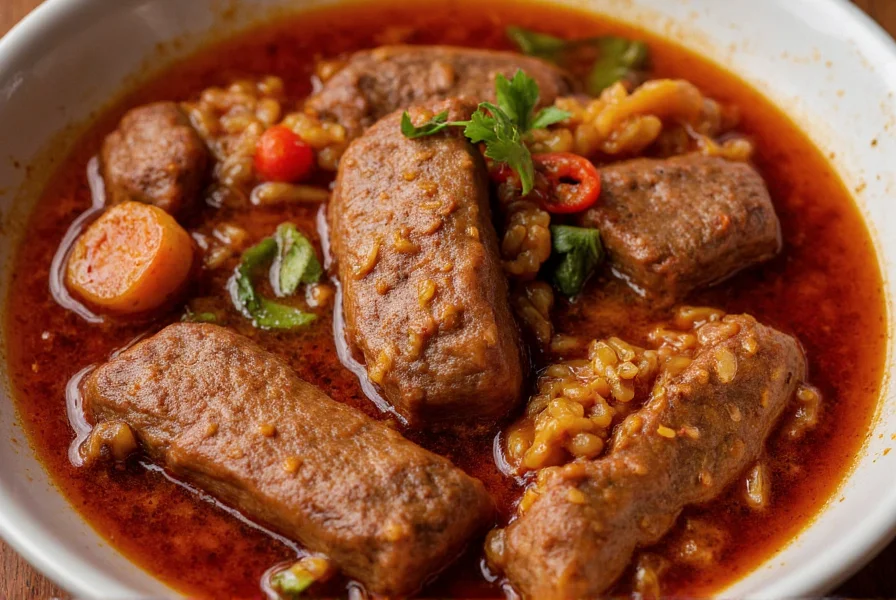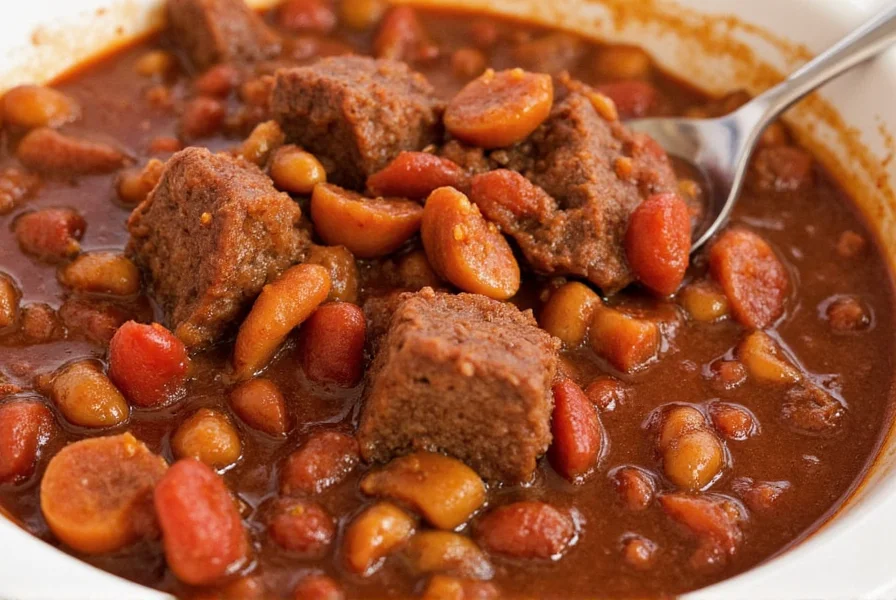Short rib chili represents the pinnacle of slow-cooked comfort food, combining the collagen-rich tenderness of short ribs with the complex spice profile of traditional chili. Unlike conventional chili made with ground beef, short rib chili requires careful attention to cooking technique to achieve its signature melt-in-your-mouth texture while maintaining robust flavor.
Why Short Ribs Elevate Chili Beyond Ordinary Versions
The magic of short rib chili begins with the cut itself. Beef short ribs contain abundant intramuscular fat and connective tissue that slowly breaks down during cooking, creating a luxurious mouthfeel impossible to achieve with leaner cuts. When prepared correctly, the meat becomes fork-tender while infusing the broth with deep umami notes. This cut's marbling ratio (approximately 30% fat to 70% meat) creates the ideal foundation for chili that satisfies both texture and flavor requirements.
| Chili Cut Comparison | Cooking Time | Texture Result | Flavor Contribution |
|---|---|---|---|
| Bone-in Short Ribs | 2.5-3.5 hours | Fork-tender, gelatinous | Rich beefiness, complex umami |
| Chuck Roast | 2-2.5 hours | Firm but tender | Good beef flavor, less complexity |
| Ground Beef | 45-60 minutes | Crumbly texture | Basic beef flavor, requires additional seasoning |
Essential Ingredients for Authentic Short Rib Chili
Creating exceptional short rib chili requires strategic ingredient selection. The bone-in short ribs (3-4 pounds) form the foundation, but the supporting cast makes the difference between ordinary and extraordinary. Key components include:
- Ancho and Guajillo chilies (2-3 each) - Toasted and rehydrated for deep, smoky-sweet base notes
- Beef bone broth (4 cups) - Enhances the natural gelatin from the ribs
- Canned fire-roasted tomatoes (28oz) - Adds acidity to balance richness
- Dark beer (12oz) - Preferably stout or porter for malty complexity
- Traditional mirepoix (2 cups diced onions, 1 cup carrots, 1 cup celery)
Achieving the perfect flavor balance requires understanding how these elements interact. The natural sweetness of slow-cooked onions counteracts the chili's heat, while the beer's bitterness cuts through the fat. This careful equilibrium defines authentic short rib chili versus simpler versions.

Step-by-Step Preparation Method
Follow this professional technique for foolproof short rib chili:
- Prep the ribs: Pat dry and season generously with kosher salt 24 hours before cooking (dry brine)
- Sear properly: Brown ribs in batches at 375°F, rendering fat without steaming
- Build flavor base: Sauté mirepoix until caramelized (20-25 minutes), then add spices
- Rehydrate chilies: Simmer dried chilies in broth for 15 minutes before blending
- Layer liquids: Add beer first to deglaze, then chili puree, then remaining broth
- Low and slow: Simmer covered at 275°F for 2.5-3 hours until meat pulls apart easily
- Finish properly: Skim excess fat, then reduce uncovered for 20 minutes to concentrate flavors
Critical Timing and Temperature Guidelines
Temperature control makes or breaks short rib chili. The collagen-to-gelatin conversion occurs between 160-205°F, requiring precise monitoring:
- Initial sear: 375°F for proper Maillard reaction without burning
- Simmering phase: Maintain 275°F (135°C) for optimal collagen breakdown
- Doneness test: Meat should separate from bone with gentle pressure at 203°F internal temperature
- Reduction phase: 300°F uncovered to thicken without curdling proteins
Many home cooks make the mistake of boiling short rib chili, which causes the meat to become stringy rather than tender. The ideal cooking environment mimics professional braising techniques where liquid barely shimmers.
Common Short Rib Chili Mistakes to Avoid
Even experienced cooks encounter pitfalls with this dish. The most frequent errors include:
- Insufficient searing time - Rushing the Maillard reaction leaves flavor on the cutting board
- Adding cold ingredients - Temperature drops disrupt the cooking chemistry
- Over-reducing the broth - Concentrates bitterness from chilies and tomatoes
- Skipping the resting period - Meat reabsorbs juices when allowed to rest 15 minutes before serving

Serving and Storage Recommendations
Short rib chili reaches its flavor peak when served with complementary elements that cut through the richness. Traditional accompaniments include:
- Cilantro-lime crema (sour cream mixed with lime zest and chopped cilantro)
- Quick-pickled red onions for acidity contrast
- Warm cornbread with honey butter
- Avocado slices for creamy texture contrast
For storage, short rib chili improves overnight as flavors meld. Cool to room temperature within 2 hours, then refrigerate in airtight containers for up to 5 days or freeze for 3 months. When reheating, add a splash of broth to restore the ideal consistency. The collagen-rich nature means it congeals when cold but returns to perfect texture when gently warmed.
Variations for Dietary Preferences
Short rib chili adapts well to various dietary needs without sacrificing quality:
- Gluten-free: Use corn masa instead of flour for thickening
- Keto: Increase meat-to-liquid ratio and omit tomatoes
- Spice-adjusted: Remove chili seeds before toasting for milder version
- Wine substitution: Replace with pomegranate molasses for depth without alcohol
Frequently Asked Questions
Can I use boneless short ribs for chili?
Yes, but bone-in ribs provide superior flavor and texture. Boneless short ribs cook faster (about 2 hours) but lack the gelatinous richness from bones. If using boneless, add 1 tablespoon unflavored gelatin to the broth to compensate for missing collagen.
How do I prevent my short rib chili from becoming greasy?
Chill the cooked chili overnight, then skim solidified fat from the surface before reheating. During cooking, avoid overfilling the pot with ribs to prevent excessive fat rendering. Proper searing also helps render fat before adding liquids, which you can discard before proceeding.
What's the ideal short rib chili consistency?
The perfect short rib chili coats the back of a spoon but still flows slowly. It should have visible gelatin strands when cooled slightly, indicating proper collagen conversion. Unlike ground beef chili, it shouldn't be soupy nor overly thick - think rich stew consistency where meat pieces remain distinct.
Can I make short rib chili in an Instant Pot?
Yes, but with modifications. Sear ribs normally, then cook at high pressure for 45 minutes with natural release. The texture differs slightly - less gelatin development but still tender. Finish with 15 minutes uncovered to reduce and concentrate flavors, as pressure cooking produces more liquid.
How do I know when short rib chili is perfectly cooked?
Test by gently pulling meat apart with two forks. Perfectly cooked short rib chili separates easily with minimal resistance while maintaining structure. The internal temperature should read 203°F, and the broth should have a slight jiggle when chilled due to gelatin content. Overcooked meat becomes mushy and loses definition.











 浙公网安备
33010002000092号
浙公网安备
33010002000092号 浙B2-20120091-4
浙B2-20120091-4